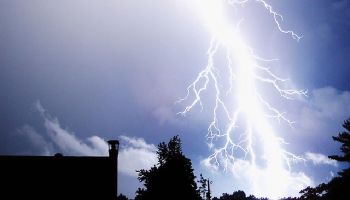Surge Protection 101: Are you ready for storm season?
- April 2, 2020
- Best Practices
- DataComm
The service life of any piece of electronically controlled equipment is, to a large degree, determined by the quality of the electrical service that is feeding it. Most electronics have an incredibly long theoretical life, but a fairly short “real-world” life. This is mainly due to two factors. The first, and by far the most critical, is the quality of the supply power. The second is environmental, including dust and dirt getting on and in the equipment.
The number one complaint from electronics owners (commercial and residential) is downtime. The number one cause of downtime (other than user error, neglect, or abuse) is poor power quality. According to Utility Industry information, power quality is at an all time low, and it’s getting worse.
With today’s electronics becoming smaller, more sensitive and more expensive no one can escape the need for quality surge protection. Every day hundreds of short duration voltage surges (some potentially larger than 5000 volts) can enter your home or business. These surges are also referred to as “spikes” or “transients”. Because transients last for a very short time (generally less than one millisecond (1/1,000 of a second)) they do not always destroy your equipment. They may be as subtle as a flicker on your computer screen or as catastrophic as the loss of an entire entertainment center. The most costly result of these small surges is the wear and tear they put on all electronics and gradual degradation. Electronic equipment can have a longer service life with the proper surge protection.
For our purposes a surge is defined as a high amplitude, short duration electrical fluctuation. A surge can be induced onto ANY metallic conductor and this conductor becomes the path of surge. There are three primary causes of surges:
- Mother Nature is responsible for the most feared and dramatic transients, those caused by lightning. While lightning is certainly spectacular, only about 2% of surge damage is caused by direct lightning strikes. Lightning hitting the ground can travel up to ½ mile so indirectly it can induce a spike on any wiring buried in the ground. Even static discharge can affect building-to-building wire runs.
- Major events like utility grid shifting, open neutral events and high voltage cross-over can induce large transients onto the power lines. Smaller, daily events like capacitor switching and inductive load switching are responsible for ongoing degradation of electronics. A large current draw such as a large motor at a gravel plant or the HVAC system at a school or hospital will create several surges a day as they cycle on and off.
- Studies by GE and the National Power Lab, in Kenosha Wisconsin, show that between 65% and 80% of all surges are generated within the facility itself. These spikes tend to be rather small and are responsible more for equipment degradation than destruction. The primary causes are HVAC equipment, pumps and motors such as pool pumps, submersible wells, and lift pump stations, refrigeration equipment, anything that on startup has an inrush current greater than it’s operational draw. Once the device reaches it’s normal run speed the excess inrush current is reflected back onto the circuit in the form of a transient surge.
Transient surges result in one of three things…Destruction, Degradation and Downtime. Destruction is erroneously, most people’s main concern. The gradual degradation of equipment causes more frequent replacement and those annoying “glitches” so prevalent in electronics today. Downtime is easily the most expensive result of a spike. A large tele-marketing company could potentially lose thousands of dollars if their phone and / or internet service went down due to a surge.
A properly designed surge protection system can protect electronics from most incoming and internally generated surges. The design of the system and the quality of the installation can be more important than the protector itself. The reason for this is because most surge protection devices are designed to detect voltage . above their rated level and then go into a low impedance state, opening a path to ground. A surge, like all electricity, tries to find the “path of least resistance” to ground. This is why installation and grounding are such critical components of a surge protection system. Once the transient is safely diverted to ground, the protector releases its hold on ground and resets to it’s passive state and waits for the next event.
Most solid-state surge devices will shunt thousands of voltage spikes without suffering any damage. When a protector does self-sacrifice, it will stay in the shunt to ground mode until disconnected and replaced. There are really only two things that can damage the Surge Protective Device (SPD). The first is a major transient surge larger than the device’s capacity. The second, is a “continuous” over-voltage situation. In either event, the protector must be replaced.
Credit:
DITEK Surge Protection »Surge Protection 101 Whitepaper (PDF)
